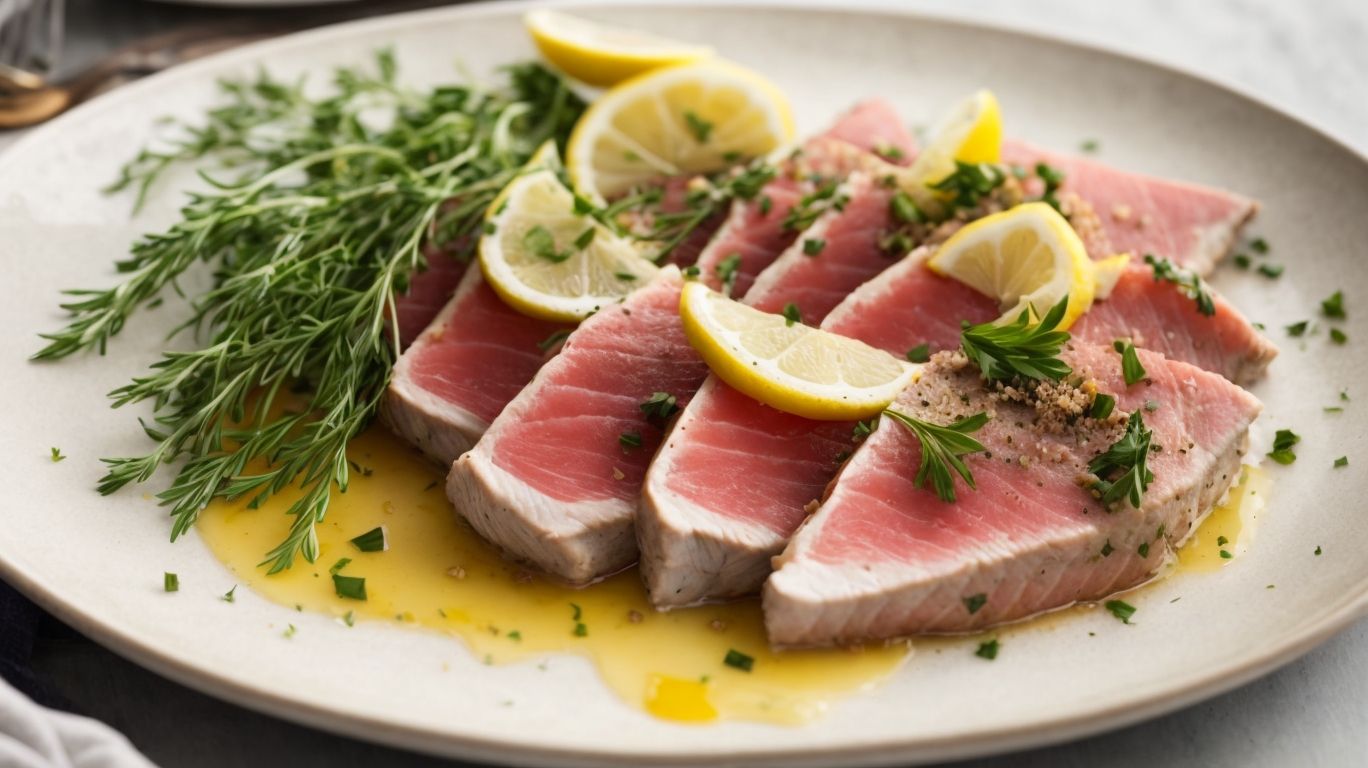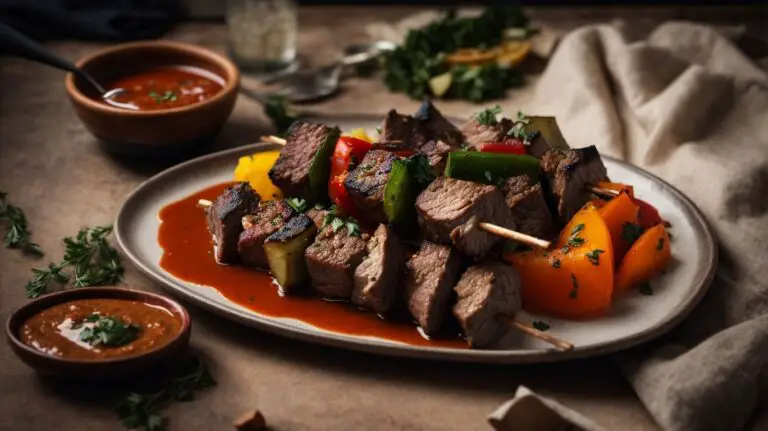How to Cook Yellowfin Tuna?
Are you looking to elevate your cooking skills and impress your friends and family with a restaurant-quality dish? Look no further than Yellowfin Tuna!
In this article, we will explore everything you need to know about this popular fish, from how to select and prepare it to different cooking methods and tips for perfecting your dish.
Whether you’re grilling, pan-frying, baking, searing, poaching, or smoking, we’ve got you covered.
Stay tuned for expert advice on cooking Yellowfin Tuna like a pro!
Key Takeaways:
What is Yellowfin Tuna?
Yellowfin Tuna, also known as Ahi Tuna, is a popular fish known for its rich flavor and versatility in cooking.
Along with its delicious taste, Yellowfin Tuna is prized for its firm texture and vibrant color. It is often enjoyed raw in dishes like sushi and sashimi due to its fresh and clean taste. This versatile fish is also excellent when cooked; it can be grilled, seared, or even used in salads and sandwiches. Yellowfin Tuna is a good source of protein, vitamins, and minerals, making it a nutritious choice for a balanced diet. Its high omega-3 fatty acid content also contributes to its reputation as a heart-healthy option.
Why is Yellowfin Tuna Popular?
Yellowfin Tuna has gained popularity due to its exceptional taste, nutritional benefits, and suitability for various culinary preparations such as sushi, grilling, and salads.
One key aspect that makes Yellowfin Tuna highly desirable in the culinary world is its firm texture and rich flavor. Whether lightly seared for sushi lovers or grilled to perfection for BBQ enthusiasts, this fish offers a versatile canvas for creative cooking. The high protein content and omega-3 fatty acids in Yellowfin Tuna make it a nutritious choice for health-conscious individuals seeking a delicious protein source.
Yellowfin Tuna’s prevalence in Mediterranean, Asian, and Pacific cuisines further illustrates its global culinary importance. Its ability to complement a wide range of flavors and cooking techniques has cemented its status as a staple ingredient in dishes like sashimi, poke bowls, and Nicoise salads.
How to Select and Prepare Yellowfin Tuna
Selecting and preparing Yellowfin Tuna involves choosing fresh cuts, handling raw fish safely, and exploring creative recipes to enhance its natural flavors.
When choosing Yellowfin Tuna, look for firm, moist flesh with a vibrant red hue, indicating freshness. It’s essential to purchase from reputable fishmongers or markets known for their high-quality seafood. To ensure food safety, store the tuna in the refrigerator and use it within a day or two of purchase. When preparing the fish, make sure to remove any bones or skin meticulously. Consider marinating the tuna in a zesty citrus dressing before grilling for a burst of flavor. Incorporating bold spices like paprika or cumin can also elevate its taste profile.
What to Look for When Buying Yellowfin Tuna?
When buying Yellowfin Tuna, ensure that the fish is fresh, free of any fishy smell, and sourced from reputable suppliers to minimize the risk of contamination.
Look for Yellowfin Tuna that has vibrant, shiny skin and firm flesh, indicating its freshness. The eyes of the fish should be clear and bulging, not sunken.
Checking the gills can also help determine freshness; they should be bright red or pink, not dull or discolored. Regarding quality standards, opt for tuna that is sustainably caught to support environmentally friendly practices. To prevent parasites and spoilage, it is crucial to store Yellowfin Tuna at proper temperatures, ideally below 40°F, and to consume it within a couple of days of purchase.
How to Properly Store Yellowfin Tuna?
Properly storing Yellowfin Tuna involves refrigerating it at the right temperature, using airtight containers, and following safe thawing practices to maintain its quality and taste.
When refrigerating Yellowfin Tuna, it is vital to keep it at a temperature below 40°F (4°C) to ensure freshness and prevent bacterial growth. Storing the fish in an airtight container or wrapping it tightly in plastic wrap can help maintain its moisture and prevent it from absorbing odors from other foods in the fridge.
Thawing frozen Yellowfin Tuna should be done gradually in the refrigerator or using cold water, never on the countertop or in warm water, to prevent bacteria from multiplying rapidly. This slow thawing process helps preserve the texture and flavor of the fish.
To avoid bacterial contamination, always wash your hands, utensils, and countertops thoroughly after handling raw Yellowfin Tuna. Ensure that any leftovers are promptly refrigerated at the correct temperature to maintain food safety.
How to Prepare Yellowfin Tuna for Cooking?
Preparing Yellowfin Tuna for cooking involves marinating it in a blend of soy sauce, sesame oil, and citrus juices to enhance its flavor and texture, with options for creative garnishes and recipe variations.
To marinate Yellowfin Tuna effectively, ensure the fish is fresh and of high quality to allow the flavors to infuse properly. The soy sauce brings a savory umami element, while the sesame oil adds nuttiness and richness. Citrus juices, such as lemon or lime, provide a refreshing zing that complements the fish’s natural sweetness.
When marinating, it’s essential to refrigerate the tuna for at least 30 minutes to let the flavors meld. For a bolder taste, consider adding minced garlic, grated ginger, or a touch of honey to the marinade for depth and complexity.
Methods of Cooking Yellowfin Tuna
Yellowfin Tuna can be cooked using various methods such as grilling, pan-frying, baking, searing, poaching, or smoking, each offering unique flavors and textures to complement this versatile fish.
-
Grilling Yellowfin Tuna is an excellent way to enhance its natural flavors while achieving a delicious smoky aroma. Marinate the tuna steaks in a blend of olive oil, garlic, lemon juice, and herbs before grilling them over medium-high heat for a few minutes on each side.
-
For pan-frying, coat the tuna steaks with a light dusting of seasoning and quickly sear them in a hot skillet with a splash of olive oil. This method locks in the moisture and creates a crispy outer crust.
-
Baking Yellowfin Tuna is a gentle method that preserves its tenderness. Season the tuna steaks with herbs and spices, wrap them in foil packets with vegetables, and bake until the fish flakes easily with a fork.
-
Searing Yellowfin Tuna involves quickly cooking the outer layers to create a caramelized crust while leaving the center rare. The key is to heat a pan until very hot, sear the tuna for a minute on each side, and slice thinly for serving.
-
For a delicate preparation, poaching Yellowfin Tuna in a flavorful broth maintains its moisture. Simmer the tuna gently in a mixture of water, wine, herbs, and aromatics until cooked through but still tender and juicy.
-
Smoking Yellowfin Tuna infuses it with a rich, smoky flavor. Use a smoker with wood chips like hickory or cedar, and smoke the tuna at a low temperature until it’s cooked to your desired doneness.
Grilling
Grilling Yellowfin Tuna is a popular method that imparts a smoky flavor and delightful charred exterior, requiring precise searing time and offering versatility in pairing with vegetables like green beans and broccoli.
Regarding searing Yellowfin Tuna, it’s crucial to preheat the grill to high heat to achieve that perfect sear while keeping the fish tender and moist inside. A common rule of thumb is to grill the tuna for about 1-2 minutes per side to achieve a medium-rare doneness.
As for garnishes, a squeeze of fresh lemon juice and a sprinkle of sea salt can enhance the natural flavors of the tuna. You can also experiment with ginger soy glaze or a zesty salsa verde to add a touch of vibrancy.
Pan-frying
Pan-frying Yellowfin Tuna involves searing the fish in a hot skillet, basting it with flavorful oils or marinades, and finishing with a squeeze of fresh lemon juice for a zesty touch.
Before you start pan-frying the Yellowfin Tuna, ensure that your skillet is well-seasoned to prevent sticking during cooking. Heat the skillet over medium-high heat with a drizzle of oil to create a searing surface for the fish.
Once the skillet is hot enough, carefully place the tuna fillets into the pan, ensuring they are not overcrowded to allow even cooking. Let the fish sear without moving it for a couple of minutes to develop a delicious crust.
When it’s time to baste the tuna, use a mixture of olive oil, garlic, herbs, and a pinch of salt for added flavor. Gently spoon the basting mixture over the fish while it cooks to keep it moist and infuse it with aromatic goodness.
Remember that basting helps enhance the overall taste and juiciness of the tuna, so be generous but not overwhelming with the application.
Once the Yellowfin Tuna is perfectly seared and cooked to your preferred doneness, remove it from the skillet and transfer it to a serving plate. Squeeze a generous amount of fresh lemon juice over the tuna just before serving to brighten up the flavors and add a tangy contrast to the richness of the fish.
Pair the pan-seared Yellowfin Tuna with a side of steamed vegetables or a light salad drizzled with a vinaigrette dressing for a well-balanced and satisfying meal that showcases the exquisite flavors of this fish.
Baking
Baking Yellowfin Tuna in the oven preserves its moisture and delicate texture, requiring precise temperature control to retain its nutritional benefits such as omega-3 fatty acids.
When preparing Yellowfin Tuna for baking, it’s crucial to start with fresh, high-quality fillets. You can enhance the flavor by marinating the tuna beforehand in a mixture of olive oil, lemon juice, garlic, and herbs.
Preheat the oven to around 400°F (200°C) for the perfect baking temperature. Cooking time can vary based on the thickness of the fillets, but a general rule of thumb is to bake for 10-15 minutes per inch of thickness.
To preserve the omega-3 fatty acids and maintain the delicate texture, avoid overcooking the tuna. Flakiness is a sign that the fish is done. Serve the baked Yellowfin Tuna with a side of fresh vegetables or a citrus-based salad to complement the flavors.
Searing
Searing Yellowfin Tuna creates a flavorful crust while keeping the center tender, with garnishes like sesame seeds and a drizzle of lime juice enhancing its taste, perfect for serving over a bed of fragrant rice.
When searing yellowfin tuna, it is crucial to preheat the pan until it is smoking hot to ensure a quick, crisp sear. Pat the fish dry with paper towels to remove excess moisture, which helps achieve that desirable outer texture.
Maintaining high heat during the searing process helps caramelize the natural sugars in the tuna, enhancing its umami flavors. Opt for sesame seeds as a crunchy coating for an extra layer of flavor, and a squeeze of fresh lime juice to brighten up the dish.
Poaching
Poaching Yellowfin Tuna in a flavorful broth results in a delicate and moist fish, ideal for flaking into salads or pairing with side dishes dressed in soy sauce and sesame oil.
When selecting a broth for poaching Yellowfin Tuna, opt for a light and aromatic base such as a combination of fish stock, lemon slices, garlic cloves, and fresh herbs like dill and parsley. The gentle flavors of the broth infuse the tuna with a subtle taste that complements its natural richness.
Once the Yellowfin Tuna is poached to perfection, consider serving it chilled on a bed of mixed greens drizzled with a tangy soy sauce and sesame oil dressing. The contrast of the cool, tender tuna against the crisp freshness of the salad creates a harmonious balance of textures and flavors.
An alternative serving option is to present the poached Yellowfin Tuna alongside a warm side dish like sesame ginger noodles or steamed bok choy, allowing the fish to soak up the flavors of the accompanying dish while maintaining its tender consistency.
Smoking
Smoking Yellowfin Tuna infuses it with a smoky flavor and tender texture, making it a versatile choice for creating dishes like poke bowls or adding a kick with spicy mayo accompaniments.
When smoking Yellowfin Tuna, the type of wood used plays a crucial role in imparting distinct flavors. Hickory or cedar wood can add a robust smokiness, while fruitwoods like apple or cherry offer a sweeter profile. The smoking time and temperature should be carefully monitored to achieve the desired texture – flaky yet moist. Consider serving the smoked tuna slices with a side of pickled ginger and wasabi to complement the flavors. Experiment with different smoking techniques and pairings to create a truly exceptional culinary experience.
Tips and Tricks for Cooking Yellowfin Tuna
Enhance your Yellowfin Tuna cooking skills with expert tips on marinating, grilling, basting, and serving, ensuring a delicious and safe dining experience in line with FDA seafood guidelines.
Regarding marinating Yellowfin Tuna, consider using a mix of citrus juices, olive oil, garlic, and herbs to infuse flavor and enhance tenderness. Let the fish marinate in the refrigerator for at least 30 minutes to allow the flavors to meld together.
For grilling, preheat your grill to medium-high heat and lightly oil the grates to prevent sticking. Place the tuna on the grill and cook for about 4-5 minutes per side, depending on the thickness of the fish, to achieve a perfect sear while keeping the interior moist and flaky.
When basting the Yellowfin Tuna, make a flavorful basting sauce using ingredients like soy sauce, honey, and ginger, and brush it onto the fish during grilling to add layers of taste and moisture.
Remember, following safe seafood handling practices, such as keeping fish refrigerated until ready to cook and avoiding cross-contamination with other foods, is crucial in ensuring a safe and enjoyable dining experience.
Marinating
Marinating Yellowfin Tuna in a blend of soy sauce, sesame oil, and zesty lemon juice enhances its flavors and tenderizes the fish, perfect for creating mouthwatering dishes.
For an optimal marination, gently pat dry the Yellowfin Tuna to remove excess moisture before generously coating it with the marinade mixture. Allow the flavors to infuse into the fish by refrigerating it for at least 30 minutes, or ideally up to 2 hours, ensuring a depth of taste. The umami richness of soy sauce complements the nuttiness of sesame oil, while the citrusy tang of lemon juice adds a refreshing twist, harmonizing into a symphony of flavors.
Seasoning
Seasoning Yellowfin Tuna with a medley of herbs, spices, and aromatic flavors elevates its taste profile, allowing for creative culinary expressions and personalized dishes.
Each herb and spice contributes its unique essence to the Yellowfin Tuna, creating a symphony of flavors that tantalizes the taste buds. For instance, a blend of garlic, ginger, and lemongrass infuses a vibrant Asian-inspired twist to the dish, while a sprinkle of coriander and cumin adds a warm, earthy depth. Lime zest and black pepper introduce a zesty kick, while fresh dill and parsley bring a refreshing herbal note. The possibilities are endless when it comes to seasoning Yellowfin Tuna, providing a canvas for culinary artistry.
Temperature and Timing
Maintaining the correct cooking time and temperature when preparing Yellowfin Tuna is vital for food safety and preventing the risk of parasites, ensuring a delicious and healthy meal.
Yellowfin Tuna, a highly prized fish for its mild flavor and versatility in recipes, requires careful attention to cooking specifics. When cooking this delicacy, it’s essential to use a food thermometer to ensure that the internal temperature reaches a minimum of 145°F to kill any potential bacteria or parasites. Remember that overcooking can result in dry and tough tuna, so following precise cooking times is crucial.
Moreover, proper handling of raw yellowfin tuna is equally important to reduce the risk of cross-contamination. Always thaw frozen tuna in the refrigerator, and avoid leaving it at room temperature for extended periods. Be diligent in cleaning all surfaces and utensils that come in contact with the raw fish to maintain a sanitary cooking environment.
Serving Suggestions
Explore innovative serving ideas for Yellowfin Tuna, such as pairing it with fragrant rice bowls, incorporating it into avocado toast, or creating a healthy low-carb meal for a delightful culinary experience.
For an exquisite dining experience, consider serving marinated Yellowfin Tuna slices atop a bed of steaming jasmine rice with a drizzle of citrus-infused soy sauce.
Alternatively, elevate your avocado toast game by layering creamy avocado, seared Yellowfin Tuna chunks, and a sprinkle of sesame seeds for added texture and flavor.
If you’re looking for a lighter option, experiment with Yellowfin Tuna ceviche served in crisp lettuce cups for a refreshing and low-calorie meal bursting with zesty flavors.
Conclusion

Credits: Poormet.Com – Kevin Johnson
In conclusion, Yellowfin Tuna stands out as a versatile and nutritious ingredient that offers a plethora of culinary possibilities, enriched with essential nutrients and health benefits.
Yellowfin Tuna is renowned for its firm texture and mild flavor, making it a favorite in dishes such as sushi, sashimi, salads, and grilling. This fish is a rich source of high-quality protein, omega-3 fatty acids, vitamin D, and selenium, which are crucial for overall health. Yellowfin Tuna contains low levels of mercury compared to other types of tuna, making it a safe choice for regular consumption. Its nutrient profile supports heart health, brain function, and immune system strength, making it a valuable addition to a balanced diet.
Final Thoughts on Cooking Yellowfin Tuna
In wrapping up the discussion on cooking Yellowfin Tuna, it’s evident that the fish’s adaptable nature, distinct flavor profiles, and healthful properties make it a prized ingredient for diverse and satisfying meals.
With its delicate yet meaty texture, Yellowfin Tuna lends itself well to various culinary techniques, whether it’s grilled to perfection, seared quickly for a crispy exterior, or even enjoyed raw in sushi and sashimi.
The versatility of Yellowfin Tuna extends beyond its cooking methods, as it pairs harmoniously with a wide array of flavors, from zesty citrus marinades to aromatic herb rubs, offering a gastronomic journey with each bite.
The nutrient-rich profile of Yellowfin Tuna, packed with lean protein, essential omega-3 fatty acids, and various vitamins and minerals, underscores its significance in promoting a well-rounded and health-conscious diet.
Frequently Asked Questions
How to Cook Yellowfin Tuna?
1. What is the best way to cook yellowfin tuna?
The best way to cook yellowfin tuna is to sear it on a hot pan for a few minutes on each side, leaving the middle rare. This will give the tuna a nice crust while keeping the inside tender and flavorful.
2. Can I grill yellowfin tuna?
Yes, grilling is also a great way to cook yellowfin tuna. Make sure to oil the grill grates and heat them to medium-high heat. Grill the tuna for about 4 minutes on each side for a medium-rare result.
3. How do I know when yellowfin tuna is cooked?
The best way to tell if yellowfin tuna is cooked is by using a meat thermometer. The internal temperature should reach 145°F for medium-rare and 160°F for medium. You can also check the color of the tuna, which should be pink in the middle for medium-rare.
4. Can I marinate yellowfin tuna before cooking?
Yes, marinating yellowfin tuna can add even more flavor to the fish. Just be sure not to marinate for too long, as the acid in the marinade can start to cook the fish. 30 minutes to an hour is usually enough time.
5. Is yellowfin tuna safe to eat raw?
While it is generally safe to eat raw yellowfin tuna, it is always best to use caution and purchase sushi-grade tuna from a reputable source. If preparing sushi or sashimi at home, make sure to handle the fish properly and consume it within 24 hours.
6. What are some other cooking methods for yellowfin tuna?
Besides searing and grilling, you can also bake, broil, or even poach yellowfin tuna. These methods may take a little longer, but can still result in a delicious and healthy meal. Experiment with different seasonings and sauces to find your favorite way to cook yellowfin tuna.





